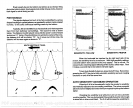
of the X-40
including
8CC, Discrimination,
and
Upper
Limit. When other
If a
partial
arch
occurs most of the time on
your
unit
(the
mark
functions are described in
this
manual,
the CLEAR
key's operation
will
be
explained
in detail.
AUTO
____
Turning
the X-40 on
enables the automatic mode. To switch to the
manual
mode,
pressthe
AUTO
key
located above the ON
key. Pressing
the
AUTO
key
erasestheword
AUTO atthe
topof
the
display.
This cancels auto
sensitivity
and
ranging, giving you
complete
manual control of the unit.
Return
the X-40 to automatic at
any
time
by pressing
the AUTO
key again.
curves
up,
but not back
down,
or
vice-versa)
it
could be the transducer is
not
pointing straight
down.
Adjust
a
transom mounted transducer until the
fish show the distinctive
arch. This
maytake
some trial and error until
you
achieve the correct
mounting.
Remember,
there must be
some movement between the boat and
thefishto
developthe
arch.
Usually,
this
meanstrolling atveryslowspeeds
with
the main
engine
in
gear
at a minimum
throttle
selling.
Thedepth
of thewaterwill affectthe size and
shape
of the fish arch
duetothe
coneanglediameter. Forexample,
if
thecone
passes
overafish
in shallow
water,
the
signal displayed
on the X-40
may
not arch at all. This
is
due to the narrow cone diameter and the
resolution limitations of the
display.
SENSITIVITY
—1 I1 ii kq
I
—
IGRAYLINEI
i.e_i
SET
When first turned
on,
the X-40
is
in
the AUTO SEARCH mode. The
micro-computer automatically adjusts
the
sensitivity
and
range
to find and
lock onto
the bottom. You can leave the
sensitivity
in
the automatic mode
or
manually
adjust
it to suit conditions.
A
horizontal bar at the
top
of the
screen
displays
the
sensitMty
level.
When the
sensitivity
is at its
minimum
level,
the bar is
very
short.
Increasing
the
sensitivity
causes the bar to travel
to the
right, increasing
in
length
correspondingly. Selling
the
sensitivity
to maximum will cause the
barto extend
across the
top
of the
display. (There
are 32
steps
of
sensitivity
available.)
To
place
the X-40 in manual
mode, pressthe
AUTO
key
once. This
turns auto
sensitivity
off. The word AUTO at the
top
of the
display
will
disappear,
signifying
that the X-40 is in
the manual mode. To Increase the
sensitivity, press
and hold the
right
arrow
key
until the
sensitivity
is at the
desired
level. The left arrow decreases
sensitivity
in the same manner.
Notice how
the
sensitivity
bar
moves as
you change settings.
When
you
pressthe
rightarrow key,
the bar
moves tothe
right, indicating
an
increase
in
sensitivity. Pressing
the left
arrow
key
moves the bar to the
left,
showing
the
sensitivity
has
decreased
accordingly.
You'll also seethe
change
on
the
display.
The
photo
on the next
page
shows a
graph
with too little
sensitivity.
On
the
right,
the
graph
has a
proper sensitivity setting.
A fish
along
with
higher
surface clutter are now
visible,
and the bottom
signal
has widened.
Compared
to a
paper graph,
a X-40 cannot show as fine of detail.
The
reason for this is the
pixels (dots
on the
screen)
are much
larger
than
a
paper
graph's markings.
Therefore,
the X-.40 cannot
show fish arches as
well asa
graph.
Plus,
it
requiresa
bit
morework
initiallyto
read and
interpret
the screen
than a
paper
graph.
Very
small fish
probablywill
not arch at all. Medium
sized fish will
show a
partial arch,
or a
shape
similar to an arch if
they're
in
deep
water.
Largefishwill arch,
butturnthesensitivity upin deeperwaterto
seethearch.
Because of
water
conditions,
such as
heavy
surface
clutter, thermoclines,
etc.,
the
sensitivity
sometimes cannot be increased
enough
to
get
fish
arches.
One of the best
ways
to
get
fish arches is to
expand
or "zoom" a
segmentofthewater.
For
example,
40 to
60 feet. The smaller the
segment,
the better
the screen resolution will be.
Then,
turn
up
the
sensitivity
as
high
as
possible
without
getting
too much noise on
the screen. In medium to
deep
water, this method should work to
display
fish arches.
WATER
TEMPERATURE AND
THERMOCLINES
Water
temperature
has an
important-If
not
controlling-influence
upon
the
activities of all fish. Fish are cold blooded and their
bodies are
aiwaysthe temperature
of the
surroundingwater. During thewinter,
colder
water slows down
their metabolism. At this
time,
they
need
about a fourth
as much
food as
they
consume in the summer.
8
29
PDF compression, OCR, web-optimization with CVISION's PdfCompressor


















